Key takeaways:
- Educational advocacy is crucial for ensuring that children, especially those with special needs, receive necessary support and resources.
- Effective advocacy involves building relationships with educators and engaging in meaningful conversations, rather than just focusing on legalities.
- Understanding cerebral palsy is essential for tailoring educational strategies and recognizing each child’s unique challenges and potential for growth.
- Collective advocacy among families fosters a supportive community that amplifies voices and leads to meaningful changes in educational environments.
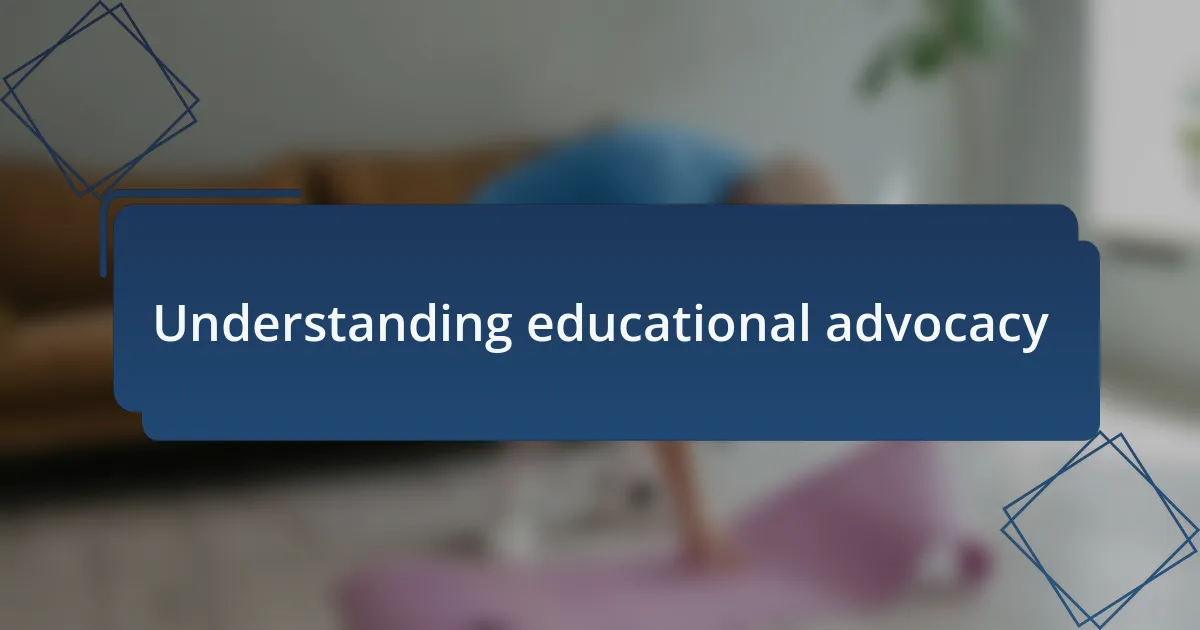
Understanding educational advocacy
Educational advocacy is about ensuring that every child, particularly those with special needs, receives the support and resources they deserve. When I first navigated the educational system for a child with cerebral palsy, I felt overwhelmed by the maze of policies and services available. It made me realize how crucial it is to have someone who understands the nuances of educational law and can voice the needs of children effectively.
I vividly remember a meeting with school officials that turned into a tug-of-war over my child’s resources. I felt a surge of emotion as I advocated for classroom accommodations that seemed so basic yet were met with resistance. This experience drove home the point: without informed advocacy, many students may not receive the tools they need to thrive academically. Have you ever felt like your voice was unheard in an important situation? That’s exactly why understanding educational advocacy is vital; it empowers you to speak up and fight for what your child needs.
As I delved deeper into advocacy, I learned that it’s not just about throwing statistics and laws around; it’s about engaging in meaningful conversations and building relationships with educators. I began to approach meetings not just as a parent, but as a partner in my child’s education, and this shift in perspective changed everything. When you engage with empathy and a willingness to collaborate, you can truly open doors that seemed closed. How have you approached advocating for your loved ones?
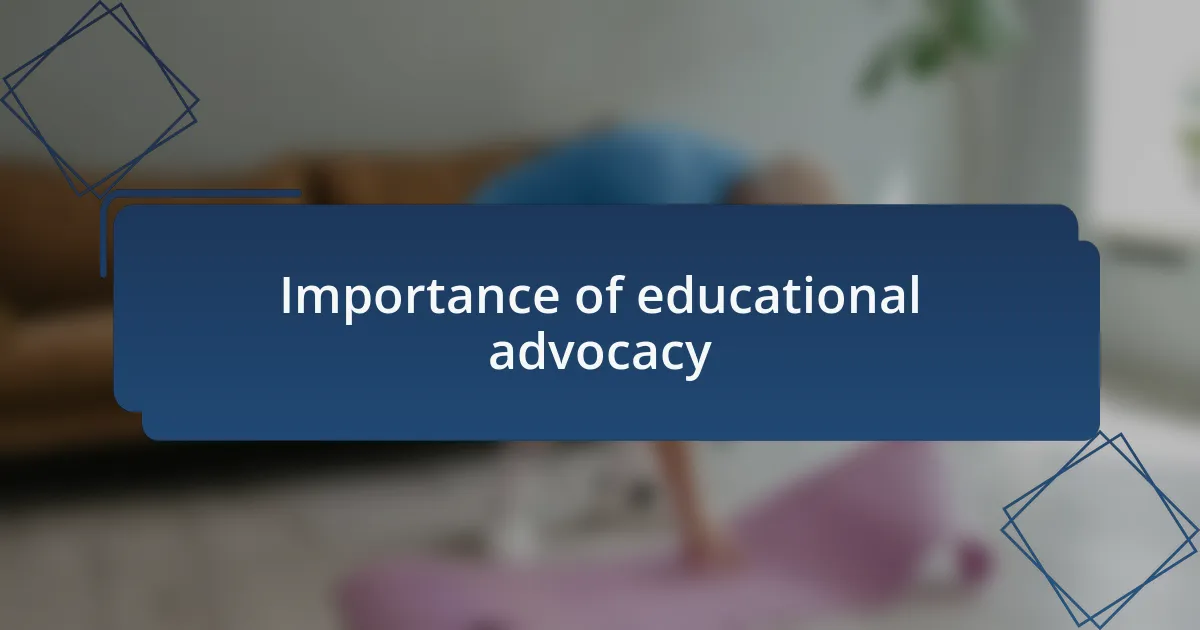
Importance of educational advocacy
Educational advocacy is a fundamental lifeline for families navigating the complex world of special education. I recall a time when I realized that without effective advocacy, my child was slipping through the cracks of a system designed to support them. It struck me: every child deserves an equal chance to succeed, and advocacy is the bridge that can close that gap.
When I found myself at a crossroads regarding my child’s Individualized Education Program (IEP), the importance of educational advocacy became glaringly clear. The team at the school seemed well-meaning, but their understanding of my child’s unique needs fell short. I remember advocating for specific therapies that could enhance their learning experience. That moment was not just about education but about ensuring my child felt validated and understood. Has your experience opened your eyes to what true advocacy can achieve in a child’s life?
As I became more involved, it became apparent that educational advocacy extends beyond individual cases; it fosters a community that champions the rights of all students with disabilities. I often found comfort in connecting with other parents, sharing stories and strategies, which strengthened my resolve. Together, we learned that when our voices unite, we create a powerful force for change. Can you recall a moment where you witnessed the impact of collective advocacy? It reinforces the belief that through educational advocacy, we can pave the way for brighter futures.

Overview of cerebral palsy
Cerebral palsy is a neurological disorder that affects movement and muscle coordination, resulting from abnormal brain development, often before birth. I remember learning that each case is unique, varying in severity and symptoms, which can range from mild stiffness to severe physical disabilities. It made me realize how essential it is to understand this condition, as it sheds light on the diverse needs of individuals with cerebral palsy.
In my journey, I discovered that numerous children with cerebral palsy also face challenges that extend to communication and sensory processing. The emotional weight of watching my child struggle with basic movements sometimes felt overwhelming, yet I found hope in the small victories, like when they achieved a new skill in physical therapy. This highlights the importance of tailored educational strategies and therapies that meet each child’s specific needs, ultimately striving for their independence and development.
Understanding cerebral palsy is not just about recognizing the challenges; it’s also about embracing the potential for growth and achievement. I often ask myself, how do we redefine success for our children? It’s about celebrating progress, no matter how small, and recognizing that with the right support, children with cerebral palsy can thrive and lead fulfilling lives. This perspective has become a core part of my advocacy efforts, reminding me of the importance of fostering an inclusive environment for all learners.
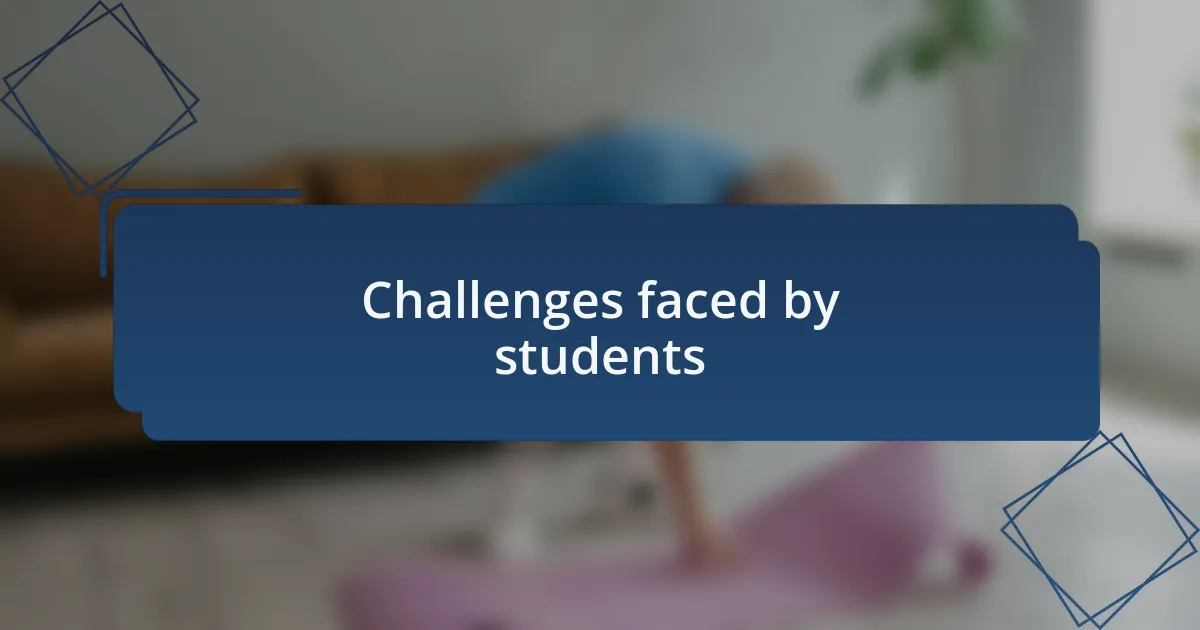
Challenges faced by students
Navigating the educational landscape can be a daunting task for students with cerebral palsy. I recall one particular moment when my child struggled to participate in a physical education class; watching them sit on the sidelines while peers engaged in activities was disheartening. It’s easy to feel frustrated as a parent, wondering why the curriculum isn’t more adaptable to their needs.
Another challenge is the social dynamics that often come into play. My child has faced moments of isolation due to their condition, making it difficult to forge friendships. I often asked myself: how do we break down these barriers? It’s crucial for schools to foster an inclusive culture where all students feel valued, regardless of their physical abilities.
Then there are the logistical issues, like transportation and accessibility within school facilities. I once experienced a frustrating situation where a simple broken elevator turned a routine day into a significant challenge. These seemingly minor inconveniences can escalate quickly, adversely affecting not only my child’s educational experience but also their emotional well-being. Have you ever considered how much these barriers can impact a student’s motivation to learn? It’s an ongoing battle that we must address collectively, advocating for change in educational settings.
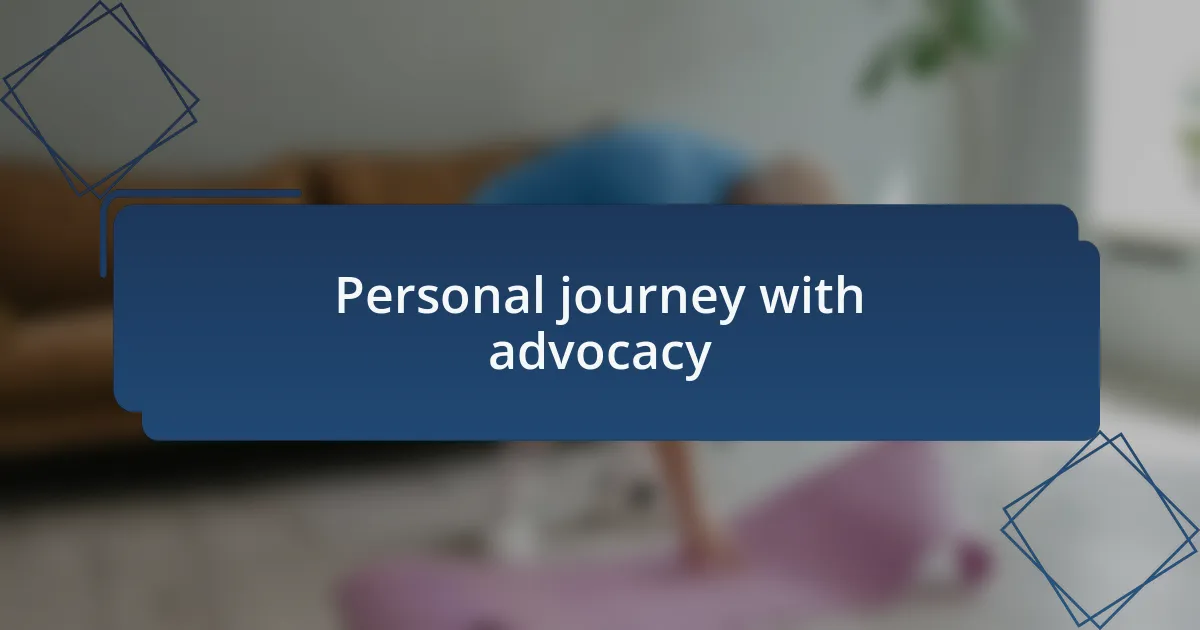
Personal journey with advocacy
Finding my voice as an advocate was not an easy path. I still remember the first meeting I attended with school administrators, armed with paperwork and a passion to ensure my child received the support needed. My heart raced as I articulated my concerns, and I wondered, would they truly listen? That experience taught me about the power of speaking up and the importance of being prepared.
As I delved deeper into advocacy, I realized that it wasn’t just about my child; it was about creating a broader change. There was a moment at a community forum where I shared stories of other families facing similar struggles. The faces in the crowd reflected a mix of empathy and understanding. It hit me then—advocacy isn’t just a solo journey; it’s a collective movement that can ignite hope and forge connections among families.
I also learned to celebrate small victories along the way. One day, to my delight, the school introduced an accessible playground. It brought tears to my eyes to see my child actively playing and laughing alongside friends. I often stop and reflect on how these changes, though perhaps small in the grand scheme, can make a profound difference in a child’s life. Isn’t that what advocacy is all about? Recognizing each step forward as a triumph worth celebrating?
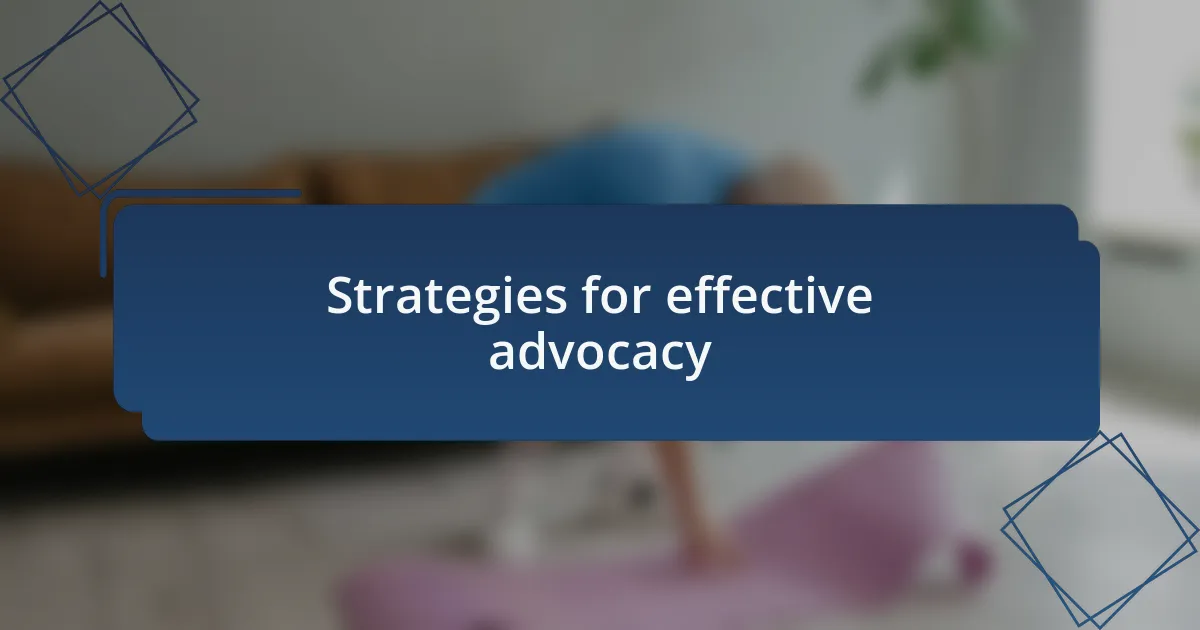
Strategies for effective advocacy
Strategies for effective advocacy require a mix of preparation and passion. One key strategy I discovered was the importance of gathering comprehensive documentation to support my case. I remember visiting the school’s resource center, sorting through assessments and reports, and thinking about how each piece served as a vital puzzle piece in showcasing my child’s needs. By being organized, I was able to present a clear narrative that resonated with educators. Have you ever noticed how a well-structured argument can shift perspectives?
Collaboration with other parents proved invaluable in my advocacy efforts. I recall a local support group meeting where we brainstormed ideas. It was enlightening to hear different viewpoints and strategies for tackling similar challenges. Building a network not only provided emotional support but also amplified our collective voice. Together, we could advocate for modifications in policy that would benefit many families, not just our own. How can we leverage our collective experiences for greater impact?
Lastly, I found that maintaining open communication with school staff was essential. I made it a point to check in regularly, sharing updates about my child’s progress and expressing gratitude for their efforts. This approach fostered a genuine partnership, making them more receptive to my advocacy. Isn’t it surprising how kindness and communication can break down barriers and create a more inclusive environment?
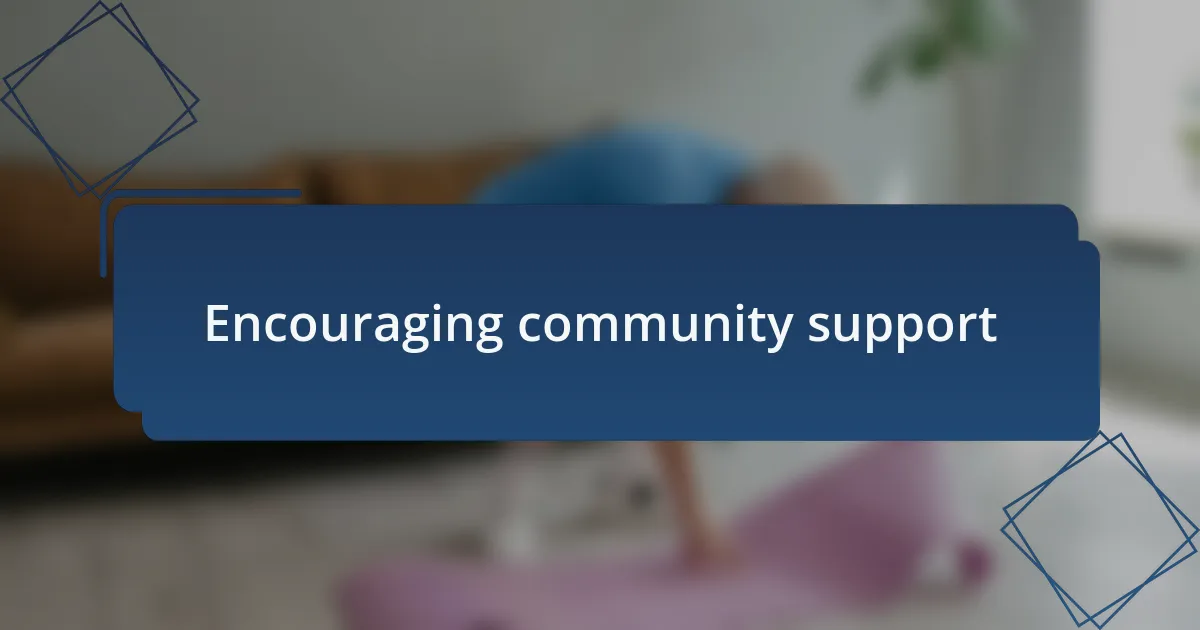
Encouraging community support
Encouraging community support plays a pivotal role in advocacy efforts. I remember the moment when a neighbor, a teacher herself, offered to organize a community fundraiser for awareness about cerebral palsy. It was heartwarming to see everyone come together, from bake sales to local businesses donating services, all aimed at making a difference. Isn’t it amazing how a single idea can ignite a wave of generosity and camaraderie?
I also found that participating in local events allowed me to connect with families facing similar challenges. At one community fair, I set up a booth sharing resources and personal stories. The conversations I had were deeply moving, with each parent expressing their unique struggles and triumphs. Have you ever felt that sense of unity? It’s like a reminder that while our journeys may be different, we all strive for the same goal—equitable opportunities for our children.
Moreover, social media proved to be a powerful tool for rallying support. I decided to create a group specifically for parents of children with disabilities, where we could share experiences and resources. The encouragement and validation I received from group members were transformative. It made me realize how important it is to have a network—someone who truly understands your journey. What would our advocacy efforts look like if we all amplified our voices in this way?